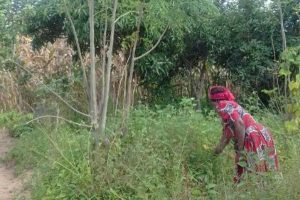ZET Blog: Moringa – The Miracle Tree
Foundations for Farming have recently been developing a plot of moringa plants, a very cheap and easy to grow crop that has many nutritional and medicinal benefits and can be produced in high yield for high profit. In this article, staff from Foundations explain more about the crop and how it can be replicated by people all over Zimbabwe and sub-Saharan Africa – no matter what land or resources you have!
Moringa is native to northern India but has become naturalised across most parts of Zimbabwe and in tropic and sub-tropic parts of Africa. Amazingly, it naturally grows in most of the regions where people suffer most from poor nutrition and food insecurity. Moringa trees grow easily even in marginal soils with very little care and minimal water requirements. The tree can be grown from seeds or cuttings and the leaves can be harvested just eight months after planting. Some people allow it to grow into a large tree – it can grow up to ten metres tall – while other people cut it back and encourage it to grow into a more bulky shrub, or even a hedge, which makes harvesting the leaves and seeds easier. The trees can also be grown in pots, bags or even the smallest yards, if they are kept pruned and controlled. This makes them ideal to grow in high density urban-areas, or even in a large pot on an apartment balcony, as well as in rural areas, particularly those areas which receive minimal rainfall.
Not only is moringa extremely easy to source and grow, but it has loads of fantastic benefits for nourishment and medicine. According to WebMD, “moringa is used for ‘tired blood’ (anaemia); buy cialis without prescription arthritis and other joint pain (rheumatism); asthma; cancer; constipation; diabetes; diarrhoea; epilepsy; stomach pain; stomach and intestinal ulcers; intestinal spasms; headache; heart problems; high blood pressure; kidney stones; fluid retention; thyroid disorders; and bacterial, fungal, viral, and parasitic infection.” Researchers in Senegal also found that it also helped pregnant women to meet their daily intake requirements and to produce more milk, due to its high levels of calcium, iron, protein and vitamins.
Moringa has gained popularity more broadly because it is highly nutritious, making it a popular supplement to meet deficiencies in diet. This is particularly helped in malnourished communities. The leaves and pods of the Moringa tree play a significant role in the nourishment of people of all ages. A 100g serving of fresh leaves is enough to meet the daily requirements of a child aged between 1-3 years for calcium, 75% iron, and 50% of the protein requirement as well as other essential nutrients. However moringa is also more versatile than this, and can be consumed as raw leaves, uncooked leaves, powder, roasted seeds, boiled pods and beans, and the flowers can also be eaten and added to dishes.
Moringa could be transformational for villages or deprived urban areas across Zimbabwe, providing nutrition and medicine for communities who cannot afford traditional sources. It is easy to find, grow and use – and due to its many benefits, it also sells for a fair profit too. If you have any more questions about moringa crops, please do get in touch with the team at ZET/Foundations for Farming and we would be happy to help.
Written by Kuda Kutesera, Project Officer, Foundations for Farming
Edited by Hannah O’Riordan, Operations Manager, Zimbabwe Educational Trust



